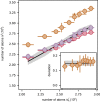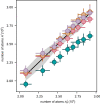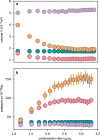A quantum engine in the BEC-BCS crossover
- PMID: 37758889
- PMCID: PMC10533395
- DOI: 10.1038/s41586-023-06469-8
A quantum engine in the BEC-BCS crossover
Abstract
Heat engines convert thermal energy into mechanical work both in the classical and quantum regimes1. However, quantum theory offers genuine non-classical forms of energy, different from heat, which so far have not been exploited in cyclic engines. Here we experimentally realize a quantum many-body engine fuelled by the energy difference between fermionic and bosonic ensembles of ultracold particles that follows from the Pauli exclusion principle2. We employ a harmonically trapped superfluid gas of 6Li atoms close to a magnetic Feshbach resonance3 that allows us to effectively change the quantum statistics from Bose-Einstein to Fermi-Dirac, by tuning the gas between a Bose-Einstein condensate of bosonic molecules and a unitary Fermi gas (and back) through a magnetic field4-10. The quantum nature of such a Pauli engine is revealed by contrasting it with an engine in the classical thermal regime and with a purely interaction-driven device. We obtain a work output of several 106 vibrational quanta per cycle with an efficiency of up to 25%. Our findings establish quantum statistics as a useful thermodynamic resource for work production.
© 2023. The Author(s), under exclusive licence to Springer Nature Limited.
Conflict of interest statement
The authors declare no competing interests.
Figures











Similar articles
-
Excitation Spectrum and Superfluid Gap of an Ultracold Fermi Gas.Phys Rev Lett. 2022 Mar 11;128(10):100401. doi: 10.1103/PhysRevLett.128.100401. Phys Rev Lett. 2022. PMID: 35333076
-
Creation of ultracold molecules from a Fermi gas of atoms.Nature. 2003 Jul 3;424(6944):47-50. doi: 10.1038/nature01738. Nature. 2003. PMID: 12840753
-
Second sound in the crossover from the Bose-Einstein condensate to the Bardeen-Cooper-Schrieffer superfluid.Nat Commun. 2021 Dec 6;12(1):7074. doi: 10.1038/s41467-021-27149-z. Nat Commun. 2021. PMID: 34873169 Free PMC article.
-
Collective excitations in two-component ultracold quantum matter.J Phys Condens Matter. 2025 Jun 12;37(25). doi: 10.1088/1361-648X/addc28. J Phys Condens Matter. 2025. PMID: 40403756 Review.
-
Life's Mechanism.Life (Basel). 2023 Aug 15;13(8):1750. doi: 10.3390/life13081750. Life (Basel). 2023. PMID: 37629607 Free PMC article. Review.
Cited by
-
The Entropy and Energy for Non-Mechanical Work at the Bose-Einstein Transition of a Harmonically Trapped Gas Using an Empirical Global-Variable Method.Entropy (Basel). 2024 Jul 31;26(8):658. doi: 10.3390/e26080658. Entropy (Basel). 2024. PMID: 39202128 Free PMC article.
-
Combining energy efficiency and quantum advantage in cyclic machines.Nat Commun. 2025 Jun 2;16(1):5127. doi: 10.1038/s41467-025-60179-5. Nat Commun. 2025. PMID: 40456741 Free PMC article.
-
Enhanced Efficiency at Maximum Power in a Fock-Darwin Model Quantum Dot Engine.Entropy (Basel). 2023 Mar 17;25(3):518. doi: 10.3390/e25030518. Entropy (Basel). 2023. PMID: 36981406 Free PMC article.
-
The promises and challenges of many-body quantum technologies: A focus on quantum engines.Nat Commun. 2024 Apr 12;15(1):3170. doi: 10.1038/s41467-024-47638-1. Nat Commun. 2024. PMID: 38609387 Free PMC article.
References
-
- Callen HB. Thermodynamics and an Introduction to Thermostatistics. Wiley; 1985.
-
- Massimi M. Pauli’s Exclusion Principle: The Origin and Validation of a Scientific Principle. Cambridge Univ. Press; 1999.
-
- Chin C, Grimm R, Julienne P, Tiesinga E. Feshbach resonances in ultracold gases. Rev. Mod. Phys. 2010;82:1225–1286.
-
- Regal CA, Ticknor C, Bohn JL, Jin DS. Creation of ultracold molecules from a Fermi gas of atoms. Nature. 2003;424:47–50. - PubMed
-
- Jochim S, et al. Bose–Einstein condensation of molecules. Science. 2003;302:2101–2103. - PubMed
LinkOut - more resources
Full Text Sources

